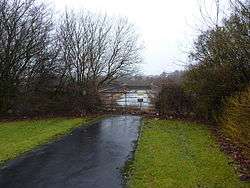Burnley Barracks
| Burnley Barracks | |
|---|---|
| Burnley, Lancashire | |
|
This section of Barracks Road (which spans the railway) is at what used to be the South West corner of the barracks site | |
 Burnley Barracks Location within Lancashire | |
| Coordinates | 53°47′21″N 2°15′40″W / 53.7892°N 2.2610°WCoordinates: 53°47′21″N 2°15′40″W / 53.7892°N 2.2610°W |
| Type | Barracks |
| Site information | |
| Owner | War Office |
| Operator |
|
| Site history | |
| Built | 1819 |
| In use | 1819-1898 |
Burnley Barracks was a military installation at Burnley in Lancashire, England. Built for cavalry, but later used for infantry and storage, military activities at the barracks declined in the late 19th century.
History
The barracks were built during an economic depression in 1819 at a cost of £5,500, nearly half funded by local landowners and businessmen hoping it would prevent rioting.[1] It was from these barracks that artillery was despatched to Rossendale during the Power-loom riots of 1826.[2] In November 1841, the barracks was the site of double-murder suicide. Private Robert Morris, a mess waiter and servant to Lt. O'Grady, had formed an intimacy with Isabella Hadden, the daughter of the mess-master. On a Sunday evening, Morris fatally stabbed Hadden and O'Grady in the officer's bedroom using a carving knife, before also killing himself.[3]
The construction of the railway in the second half of the 1840s led to rapid development around the site and the local station, originally only a temporary terminus, was re-opened as Burnley Barracks railway station in 1851.[4][5] Up to 1861, the Barracks had been used exclusively by the cavalry, usually two troops on six-month detachments. However it was then without a garrison for four years and afterwards it was only occupied for progressively shorter periods with infantry regiments sometimes based here. Among the various regiments of lancers and hussars stationed at the barracks are the Scots Greys, 5th Dragoon Guards and the 6th (Inniskilling) Dragoons, and infantry such as the 33rd Regiment of Foot, Connaught Rangers and Black Watch. For a time during the Crimean War, an Italian regiment from Piedmont was quartered here.[1]
In 1873 a system of recruiting areas based on counties was instituted under the Cardwell Reforms and the barracks became the depot for the 30th (Cambridgeshire) Regiment of Foot and the 59th (2nd Nottinghamshire) Regiment of Foot.[6] Rioting during the Burnley weavers strike in 1878 again saw troops deployed with 87 cavalry and 302 infantry supporting the police on the third day of trouble.[7] Following the Childers Reforms, the 30th Regiment and the 59th Regiment amalgamated to form the East Lancashire Regiment with its depot at the barracks in 1881.[6] With the barracks in a poor state of repair, the East Lancashire Regiment re-located to Fulwood Barracks in Preston in 1898.[8] The site was sold soon afterwards,[1] with the clearance of many buildings during the 1960s and 70s, and the construction of the M65 motorway in 1981, greatly changing the area.[5]
Layout
The first Ordnance Survey map of the area from 1848, shows the rectangular barracks located east of the town, with buildings around a central open space and entrances mid-way along the south-western boundary and at the northern corner.[9] A survey in 1846-7 listed the stone-built barracks as containing: 36 sleeping rooms, a wash-house, two cook-houses, a hospital for 16 patients and a reading room. Water was provided by three wells and 34,000 imperial gallons (154,567 l) rainwater collection system.[10]
Incidental
Sir James Yorke Scarlett who rose to prominence in the Crimean War, was a Lieutenant Colonel in the 5th Dragoon Guards in 1835 when he married Charlotte Hargreaves, a Burnley coal heiress, with the town becoming his adopted home.[11]
References
- 1 2 3 Bennett, Walter (1951), The History of Burnley, four, Burnley Corporation, pp. 230–1
- ↑ "Weavers Bloody Battle". Rossendale Free Press. 3 March 2003. Retrieved 9 December 2015.
- ↑ The Annual Register of the year 1841, 83, 1842, pp. 107–8
- ↑ Butt, R.V.J. (1995). The Directory of Railway Stations. Yeovil: Patrick Stephens.
- 1 2 "A little look by request at railway stations". Lancashire Telegraph. 4 June 2014. Retrieved 9 December 2015.
- 1 2 "Training depots". Regiments.org. Archived from the original on 18 December 2007. Retrieved 27 October 2016.
- ↑ Bennett pp.122-5
- ↑ "The Lancashire infantry museum". Retrieved 6 April 2014.
- ↑ Lancashire and Furness (Map) (1st ed.). 1 : 10,560. County Series. Ordnance Survey. 1848.
- ↑ "Parliamentary accounts and papers". UK Parliament. 23 July 1847. Retrieved 9 December 2015.
- ↑ "Scarlett's 300: Balaclava heroes". Lancashire Telegraph. 21 October 2004. Retrieved 12 December 2015.
